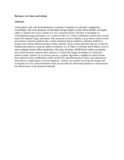| dc.description.abstract | Colour plays a key role in determining a consumer’s response to a product’s appearance. Accordingly, this study proposes an automatic design support system which enables a designer either to emulate the colour scheme of a two-coloured product and then to determine its corresponding image perception, or to search for the two-colour combination which most closely meets the required image perception. The proposed system combines a gray theory-based colour-association evaluation method and a colour-harmony-based aesthetic evaluation method to design and evaluate different product-colour schemes. Since colour-harmony theories cannot be implemented directly using the additive primaries (i.e. R (Red), G (Green) and B (Blue)) used in most computer-based colour emulations, this study develops a RGB-based colour-association and colour-harmony measurement scheme to evaluate the image perception of a particular product-colour scheme. In an inverse process, a genetic algorithm is applied to search for the near-optimal colour combination which satisfies the specified product colour-association goal and achieves a high degree of colour harmony. Various case studies involving the design and evaluation of a two-coloured thermos flask are provided for illustration purposes to demonstrate the effectiveness of the proposed method. | en |

